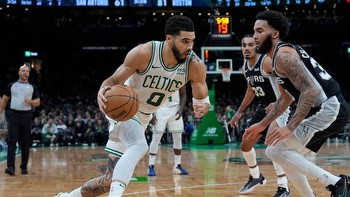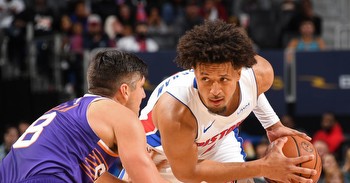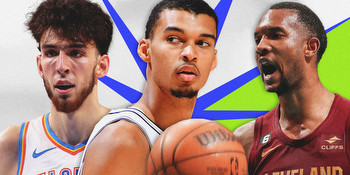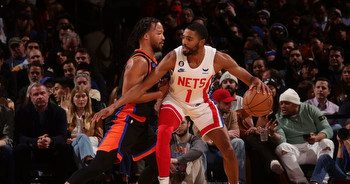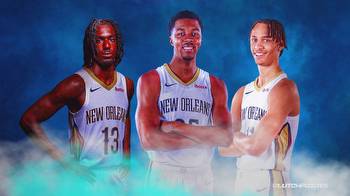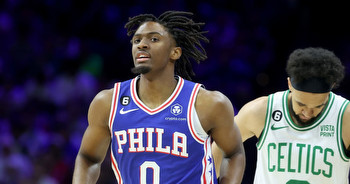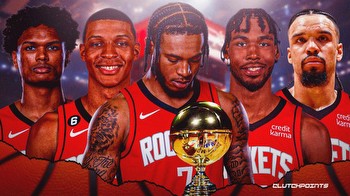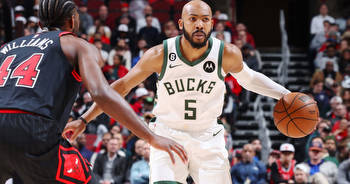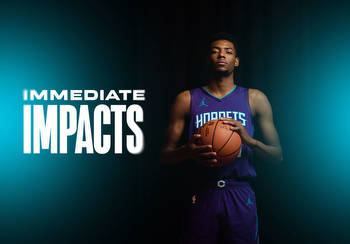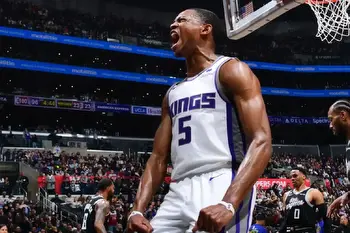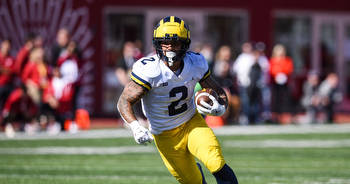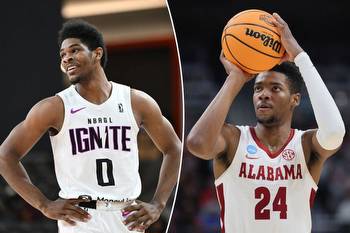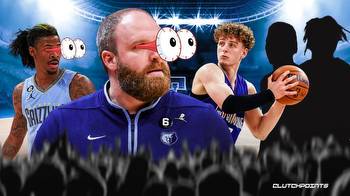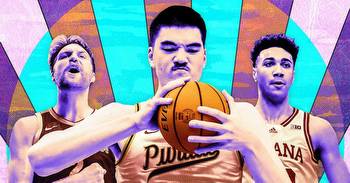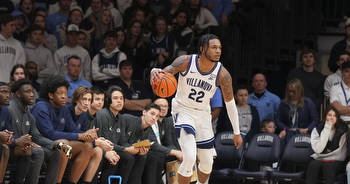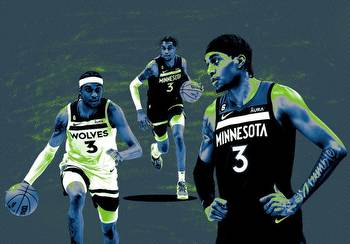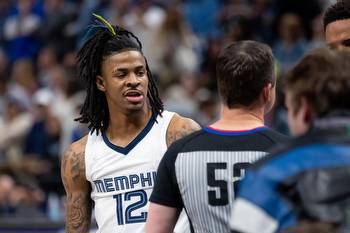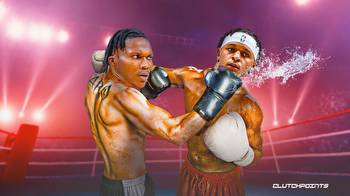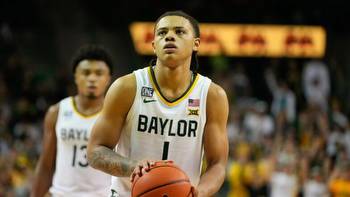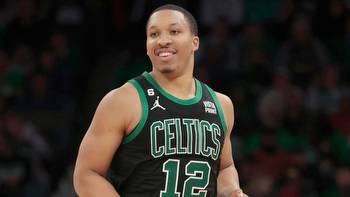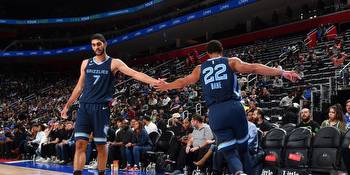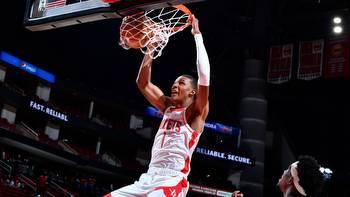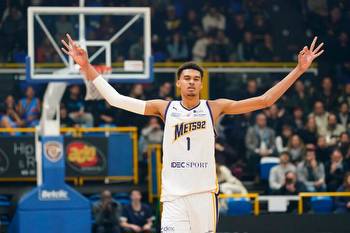The 1 Skill Every Top NBA Rookie Needs to Hone in Training Camp

Skill to hone in training camp: Playing out of double teams/pressure
There will be extraordinary attention paid to Victor Wembanyama this year. He can credit the hype, but also the mismatch he creates one-on-one as a 7'4" big with three-point range, ball-handling skill and shot-making versatility.
He did struggle at times in France playing out of double teams. They forced him into bad passes and were able get strips.
The tape shows that Wembanyama was vulnerable when playing back to the basket in the post, as he doesn't have the greatest peripheral vision to see help defenders sneaking in for a steal.
He also likes to dribble away from the pressure into space where he has more room to make a pass. But given how high his waist and handle are, it's easy for defenders to reach a hand in and knock the ball loose.
Between the Spurs having shot 34.5 percent from three last year, and Jeremy Sochan still a limited frontcourt scorer, defenses will presumably be willing to leave San Antonio's shooters to pressure the 19-year-old rookie.
Wembanyama should focus on doing a better job of making quicker reads and staying poised in tighter spaces.
Skill to hone in training camp: Creating separation off the dribble
Chet Holmgren should provide an immediate impact with translatable rim protection, tools for finishing, and a floor-spacing shooting stroke. He'll make some highlights with his transition ball-handling as well. Creating cleanly against a set defense will be Holmgren's biggest challenge early in his career.
Given his range, Holmgren likes to play around the perimeter, but his first step lacks speed, and his last step on drives lacks explosion. There is some choppiness in his one-on-one execution, and his delivery into isolation moves can be slow.
Without blow-by burst, he often resorts to a spin move that leaves him vulnerable to getting stripped, turning into traffic or going up off balance.
Holmgren should look to tighten his handle for smaller windows, and experiment with and discover new ways to get clean looks in the half court.
With offense running through Shai Gilgeous-Alexander, Josh Giddey and Jalen Williams, Holmgren figures to spend the majority of his minutes in spot-up situations. So, he should continue to raise his comfort level making quick reads off the catch and attacking closeouts.
Skill to focus on in training camp: Pull-up shooting
The pull-up is a key weapon in Scoot Henderson's bag, and NBA defenses will keep baiting him to take it based on his G League scouting report.
They'll prioritize preventing the rookie from tapping into his explosiveness and strength on drives. Despite looking comfortable and confident stepping into dribble jumpers, he was too inconsistent and erratic.
He took the second-most mid-range jumpers of any G Leaguer and made just 34.8 percent of them. He shot 31.3 percent on three-point pull-ups and 32.4 percent from deep altogether.
Henderson only attempted 2.7 threes in 30.2 minutes per game, a sign that he's clearly not comfortable yet from behind the NBA arc.
Defenses are going to sag and drop in pick-and-roll coverage and play a few feet off when guarding in isolation. And while he'll need to improve his overall decision-making and reads, that will come with reps and freedom to play through mistakes.
Becoming a more dangerous shooter off the dribble should be the clear-cut goal during training camp.
Skill to hone in training camp: Finishing self-creation offense
After having trouble finishing in the half court at Alabama, Brandon Miller will want to focus on adjusting his paint reads and lay-up package.
Though capable of playing above the rim when given an open runway for takeoff, he lacks vertical explosion without as much momentum attacking. This often forced him to stop short and attempt scoops and touch shots too far from the basket.
While there is only so much Miller can do to improve his explosion in a short period of time, he'd benefit from strengthening his left hand. He converted just 7-of-24 drives going left last year, often struggling to get all the way to the rim or resorting to stationary, contested one-handers after defenders cut him off and slowed him to a standstill.
Tightening his handle could also lead to higher-percentage finishes, as Miller's dribble got too high, making it difficult to blow by, or leaving him vulnerable to getting stripped or blocked. He shot just 31.8 percent out of isolation and turned the ball over a whopping 26.9 percent of the time in ball-screen situations.
The Charlotte Hornets also ranked No. 29 in the NBA in three-point percentage last year, so he might not get the same extra spacing as other rookies.
Skill to hone in training camp: Shot-making
Amen Thompson will be relying on transition, attacking, athletic finishes and runners to score. And NBA defenses will game-plan around his speed and quickness to make him pull up or settle for threes.
Thompson had little success shooting off the dribble, despite getting to his pull-up with some rhythm. There were defenders in Overtime Elite who either played three feet off or didn't bother closing out when he caught the ball from behind the arc. NBA defenses will show the same level of disrespect, especially given his reputation as a lightning-quick driver.
He should also be expecting to play far more reps off the ball than he's used to with Fred VanVleet and Jalen Green. Becoming a catch-and-shoot threat will be key for the rookie to earn first-unit minutes and capitalize on scoring chances without the freedom to consistently create them for himself.
Mechanically, he doesn't get legs under his shot, which is mostly stiff arms and wrists. The Houston Rockets' coaching staff figures to put an early emphasis on improving the energy transfer and release on Thompson's jumper.
Skill to hone in training camp: Off-ball scoring
In terms of areas Ausar Thompson must improve, his on-ball creation and shot-making need the most work. But based on the Detroit Pistons' lineup (featuring Cade Cunningham, Jaden Ivey and Bojan Bogdanović) and the rookie's projected role, he should use training camp to build his comfort level playing off the ball.
That starts with improving as a catch-and-shooter. He's shown an ability to get hot, but he's mostly inconsistent with stiff mechanics, limited touch and not much rhythm getting into his jumper. He can catch and hold too often before deciding to let it fly. That's likely caused by a lack of confidence, as he prefers to see what else is available before settling for the three. Although, he also has a tendency to rush an attempt to catch-and-shoot in one fluid motion.
He could use training camp reps to get comfortable exploring other ways to score with one-dribble pull-ups past closeouts, cuts and dribble handoffs.
Between Ivey and Cunningham handling the ball, and Thompson still raw in terms of executing one-on-one, he's unlikely to spend a lot of time in creation situations this season. He'll have to adjust to spending more timing standing around the arc or using off-ball movement to generate opportunities.
Skill to focus on in training camp: Shooting
Anthony Black figures to split time playing on and off the ball in a rotation that already has a number of creators.
Joining the starting lineup will mean the rookie must improve his catch-and-shoot game, assuming Markelle Fultz gets first crack at point guard and more offense will run through Paolo Banchero. Black shot just 31.0 percent on catch-and-shoot three-point attempts at Arkansas.
He'll have to improve his pull-up game (31.5 percent) as well. It's not a fluid-looking shot from Black, who has a clear hitch that slows down his release and allows defenders to contest.
He made just 37 jump shots all season as a freshman, a reason why he could only average 14.7 points per 40 minutes.
He'll make the biggest impact with his passing and defense, and he'll use his size and touch to convert runners and lay-ups off drives. But for a guard who isn't the most advanced self-creator, Black should be prioritizing his shooting development during training camp.
Skill to hone in training camp: Shot-making
As much as Bilal Coulibaly needs to improve his ball-handling and self-creation, strengthening confidence and mechanics in his jump shot is a more realistic short-term goal for his rookie season.
He shot a combined 33.6 percent from three between LNB Pro A and France's U21 league this season. That number does highlight shot-making ability, considering he made 40 threes in 53 games. But it's still below average for a wing who isn't a serious threat creating off the dribble.
In Pro A, he shot just 1-of-12 on pull-ups with an inconsistent release and little touch. Some of his misses were way off the mark. Sometimes the ball came out quickly; others it stuck in his hands too long, a sign of aiming his shot.
It will be difficult for Coulibaly to consistently score in double figures just relying on athleticism for transition finishes and cuts.
By moving up and taking him No. 7, the Wizards are betting his on-ball development long-term. In the meantime, becoming a more reliable on- and off-ball shooting threat should be his priority in training camp.
Skill to focus on in training camp: Driving/Attacking closeouts
Despite Jarace Walker's mix of power, touch and ball-handling, he was inefficient on drives. It didn't stop him from attempting them, as he seemed confident putting the ball down and using his floater.
But he shot just 36.3 percent in spot-up situations, even though he made 40.5 percent of his non-dribble jumpers. He converted a brutal 28.9 percent of his spot-up drives, frequently taking crowded routes, prematurely opting for runners or falling away to avoid shot-blockers.
He shied away from contact too much (2.2 free-throw attempts per game) for a 240-pound, chiseled forward.
Walker also needs to add some counter footwork off the dribble. He didn't adjust well when defenders anticipated his drive. They were able to force him into a contested or off-balance shot too easily.
And his first step wasn't overly dangerous, which can be tied to ineffective fakes and slow movement into his drives.
It wouldn't hurt for Walker to spend extra time on his pull-up game, but his field-goal percentage will suffer if he doesn't strengthen his awareness, feel and skill execution on takes to the basket.
Skill to focus on in training camp: Driving/Attacking closeouts
The John Collins signing will limit Taylor Hendricks' rookie minutes. And when he does get on the floor, he'll play a spot-up heavy role that uses him as a stretch-4 and values his shooting. The scouting report will call for defenses to close out hard, because Hendricks was accurate from deep at Central Florida and limited when forced to put the ball down.
Mostly a straight-line driver, he showed little ability to counter with a ball-handling move, or with adjustment as a finisher. He converted just 44.7 percent of his layups, a number that reflects poor touch on the move. The rim seemingly shrinks for Hendricks when he's attempting a shot off of his own creation inside the arc.
He didn't do well when shot-blockers contested at the rim, and he showed clear weakness when having to use his left hand.
It's unrealistic to expect Hendricks to develop into an isolation or go-to scoring option, but he'll need to find ways to score when he's not getting open spot-up threes or his catch-and-shoot game isn't working.
Cason Wallace, Oklahoma City Thunder
Skill to hone: Creating advantages
Wallace's versatility and defense should make him an easy plug-and-play rookie. But in training camp, he could start to add new ways to create advantages at the point of attack, where he lacks some burst off the dribble.
There isn't a lot of variety to his creation. His basic dribble-drive game led to a lot of low-percentage, contested runners at Kentucky. He should ultimately look to add more moves, hesitations or tricks to lose defenders in ball-screen or isolation situations.
Jett Howard, Orlando Magic
Skill to hone: Shooting consistency
The Magic coaches will want Howard to eventually expand his off-the-dribble game. They'll want his defense to improve right away. But realistically, shooting consistently will be his key to rookie minutes and value to the rotation.
Howard brings translatable shot-making versatility with his 6'8" size, movement-shooting and pull-up game. He was just streaky last season, finishing below 30.0 percent from three in 13-of-29 games played.
Dereck Lively, Dallas Mavericks
Skill to hone: Non-dunk finishes
At 7'1", 230 pounds, Lively shot just 13-of-25 on lay-ups, 3-of-10 on short hooks and 1-of-8 on tips. The Mavericks will need him to convert far more often below the rim when it's not an easy alley-oop or uncontested finish.
Lively showed some poor touch and an unwillingness to use his left hand or turn over his right shoulder. He was a non-threat in the post at Duke, so Dallas is unlikely to use him in back-to-the-basket situations, anyway. But he'll want to find ways to score more effectively when he has the ball around the low blocks.
Gradey Dick, Toronto Raptors
The Raptors and Dick should be able to bank on his shooting. Self-creation is an obvious weakness, but it's also unrealistic to expect he'll suddenly (or even eventually) evolve into a go-to scorer. Aside from open lanes when attacking closeouts, he struggled to get all the way to the basket at Kansas, lacking the burst, upper strength and explosive last step. Adding a floater will be key for his two-point scoring, and he only made 6 of 21 running attempts at Kansas.
Jordan Hawkins, New Orleans Pelicans
Skill to hone: Pull-up shooting
Hawkins was the draft's most productive three-point and off-screen shooter. He wasn't as effective when forced to put the ball down and pull up. He shot below 35.0 percent on both two-point and three-point dribble jumpers. And given his limited creation and projected role, he's not likely to spend much time getting all the way to the rim.
Kobe Bufkin, Atlanta Hawks
Skill to hone: Playmaking
Bufkin has a chance to earn a 10-15-minute role handling the ball for the Hawks' second unit. And with shot-makers like AJ Griffin and Bogdan Bogdanović coming off the bench, and Onyeka Okonwu playing a finisher role, Bufkin's focus should be on playmaking.
Bufkin showed some obvious passing IQ at Michigan, particularly in a setup role in ball-screen situations. He'll have the chance to add the most value to Atlanta's rotation picking apart defenses as a pick-and-roll facilitator.
Keyonte George, Utah Jazz
Skill to hone: Playmaking
Though George is wired to score, he has the best chance to climb the Jazz depth chart by showing he can add value with playmaking. He's a skilled passer that his assist-to-turnover ratio at Baylor may have hid. Earning the most minutes and biggest role in Utah will mean making a case for playing time at point guard. And though he'll always be the shoot-first type, he has flashed the shiftiness, IQ, patience and passing skill to operate as an effective ball-screen setup man once his mindset shifts off scoring.
Jalen Hood-Schifino, Los Angeles Lakers
Skill to hone: Playmaking
The Lakers' rotation should have enough scoring options for their first and second unit. The bench could use a facilitator, however, with Gabe Vincent, Taurean Prince and Cam Reddish valued for their shot-making.
Hood-Schifino isn't the most natural off-ball player, so if he's going to earn minutes, it will be for his ability to pass as a 6'6" lead ball-handler. Dating back to his time at Montverde, he's shown he can settle into a quarterback role and facilitate offense.
Jaime Jaquez Jr., Miami Heat
Skill to hone: Spot-up shooting
Jaquez's identity revolves around versatility and toughness, features of his game that will help the rookie earn playing time early. But the Heat role players must be able to shoot, and he shot below 32.0 percent from three his last two years at UCLA.
He did have more of a creation workload than he'll have in Miami, so he should see more rhythm, catch-and-shoot looks with the Heat. Working on hitting those spot-up and corner threes should be Jaquez's priority in training camp.
Brandin Podziemski, Golden State Warriors
Skill to hone: Shot-making
Whether Podziemski's passing or shot-making is more important to Golden State remains debatable. But playmaking IQ typically translates, and based on the eye-test results on his 5.3 assists per game in summer league, he is going to have an easier time setting up teammates (using his unteachable IQ, vision, feel) than scoring.
The guards defending in the NBA will look far different from the ones in the West Coast Conference. He'll want to focus on rebuilding his shooting confidence in training camp, particularly given the challenges he'll face trying to score inside the arc, thanks to his limited athleticism, strength and length.
Cam Whitmore, Houston Rockets
Skill to hone: Self-creation
Whitmore should serve as a useful spot-up shooter for the Rockets' second unit. But assuming Kevin Porter Jr. won't be suiting up for Houston, the rookie will also have an opportunity to create.
He has a signature step-back three, but he struggled to make off-the-dribble reads inside the arc. Whitmore converted 3-of-16 two-point jumpers last season and had a tendency to force plays into traffic. His 19 assists to 42 turnovers at Villanova reflect tunnel vision.
An immediate to-do list should include improving his mid-range pull-up, floater (2-of-9) and awareness while creating.
Stats courtesy of Synergy Sports, Sports-Reference.com

